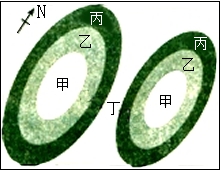读某地水平面的岩层分布图(从甲到丁岩层从老到新),回答题。

小题1:丁地的地质构造为
A.褶皱
B.向斜
C.背斜
D.断层小题2:关于图中各地的叙述,正确的是
A.甲为良好的储油构造
B.甲有利于储存地下水
C.修一南北向隧道应选址丁处
D.图中岩层为岩浆岩
小题1:B
小题2:A
题目分析:
小题1:由图可知,甲地的岩层中间老两翼新,根据岩层的新老关系判断,甲地为背斜;丁地的岩层中间新两翼老,故丁地的地质构造为向斜。
小题2:甲为背斜,为良好的储油构造,修一南北向隧道应选址甲处,丁地向斜,有利于储存地下水,图中岩层具有层理构造,为沉积岩。
点评:本题难度中等,解答本题的关键是:(1)明确地质构造的判断方法。(2)熟练掌握地质构造规律的应用。
【方法技巧】地质构造
1.褶皱与断层的对比分析
| 地质构造 | 褶皱 | 断层 | ||
| 背斜 | 向斜 | |||
| 判断方法 | 从形态上 | 岩层一般向上拱起 | 岩层一般向下弯曲 | 岩层受力断裂并沿断裂面有明显的相对位移。 |
| 从岩层新老关系上 | 中心部分岩层较老,两翼部分岩层较新。 | 中心部分岩层较新,两翼部分岩层较老。 | ||
| 图示 |  |  | ||
| 构造地貌 | 未侵蚀地貌 | 山岭 | 谷地或盆地 | 大断层常形成裂谷或陡崖,如东非大裂谷。地垒常形成块状山或高地,如华山、庐山、泰山;地堑常形成谷底或低地,如渭河谷地、汾河谷地,沿断层线常发育成沟谷,有时有泉、湖泊。 |
| 侵蚀后地貌 | 谷地或盆地 | 山岭 | ||
| 图示 |  | |||
地质构造规律有很强的实践性,对生产有指导作用。
(1)利用向斜构造找水:向斜构造有利于地下水补给,两翼的水向中间汇集,下渗形成地下水,故打井可在向斜槽部打。

(2)利用背斜找油:背斜是良好的储油构造。由于气最轻,分布于背斜顶部,水的密度大,分布由于底部,中间为石油。

(3)利用向斜、背斜确定钻矿位置:背斜顶部易被侵蚀,背斜岩层中的矿石很可能被搬运走了,因此岩层中若含有某种矿产如煤、铁矿等,往往保留在向斜部分的地下,钻矿或打井应在向斜构造处。
(4)利用断层找水:断层往往是地下水出露的地方。
(5)建筑、工程隧道选址:在断层地带搞大型工程易诱发断层活动,产生地震、滑坡、渗透等不良后果,造成建筑物塌陷,因此选址应避开断层。开凿隧道时应避开向斜部位,因为向斜是雨水的汇集区,隧道可能变为水道。
